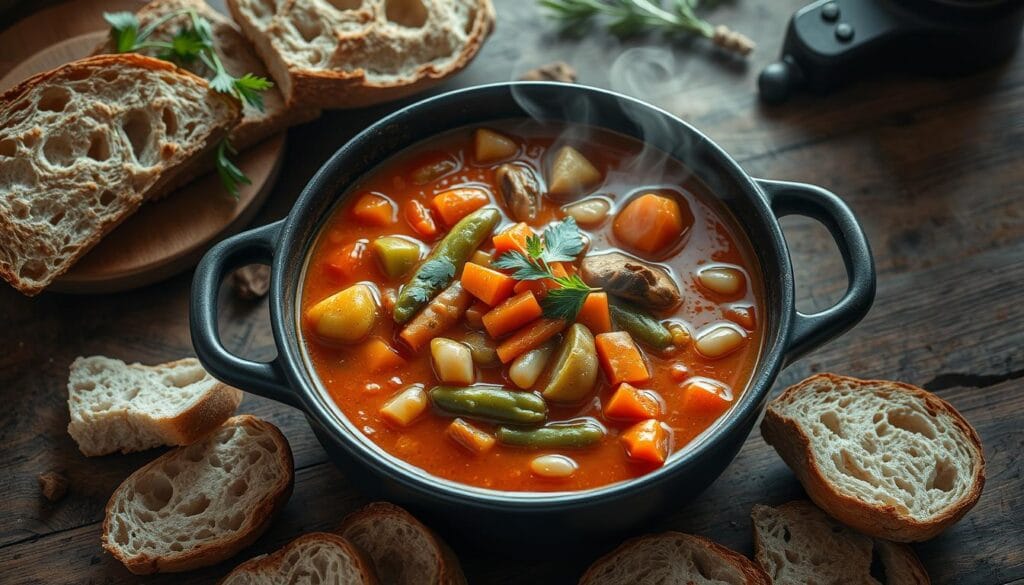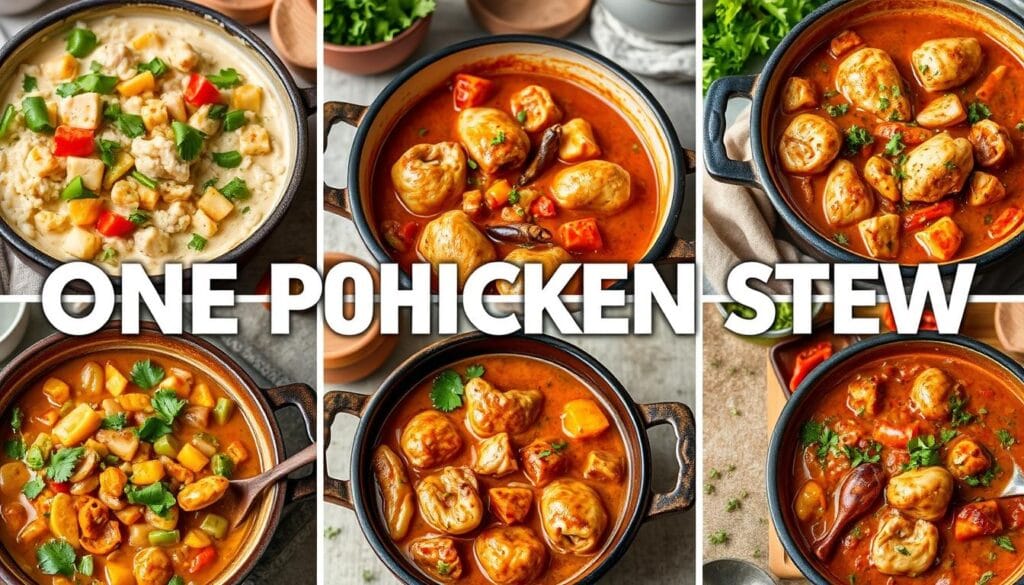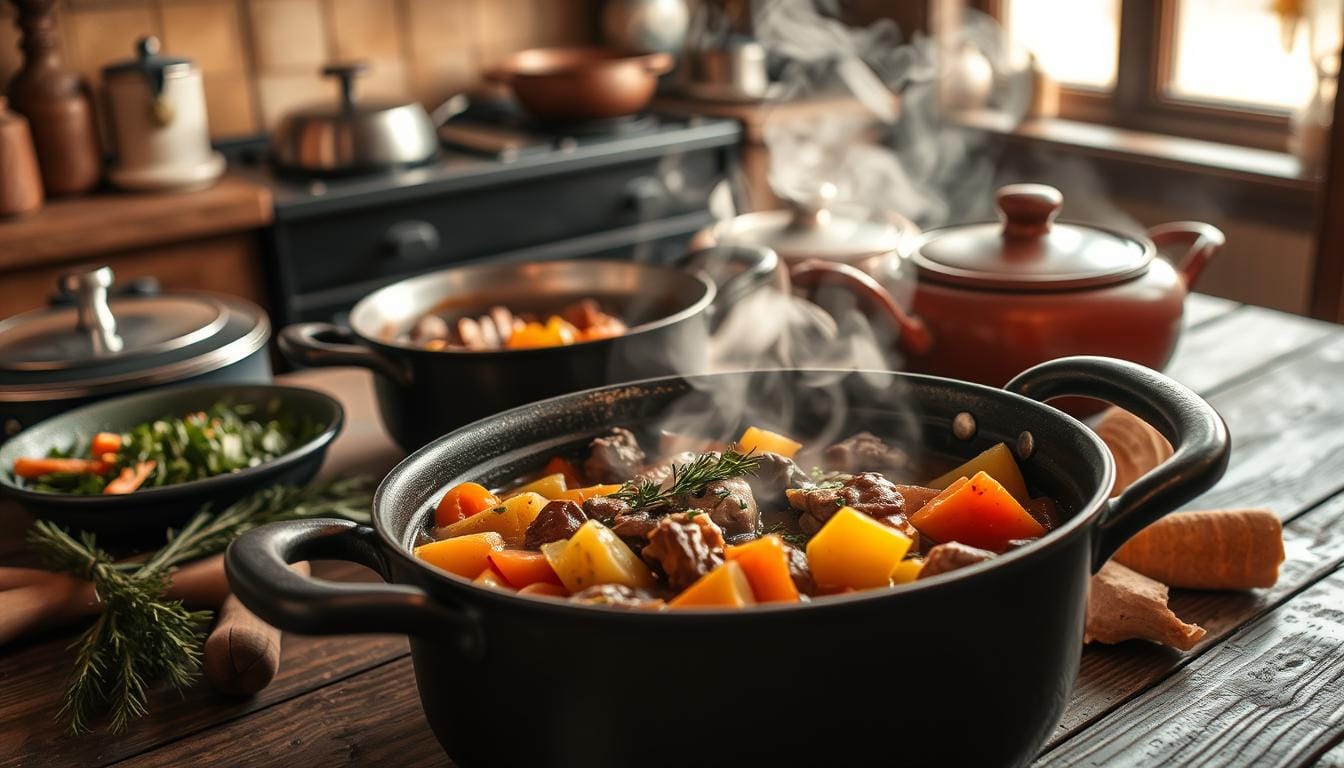Delicious Stew Pot Recipes for Cozy Meals
When it gets cold, nothing beats a warm stew pot. It’s filled with rich, comforting flavors. Start your journey through one-pot meals with classic and new stew recipes. They turn simple ingredients into amazing meals.
Stews are more than food; they celebrate global culinary traditions. Whether you want a classic beef stew or something new, these dishes warm your heart and belly.
Stews come in many flavors and textures. You’ll find everything from tender meat dishes to colorful vegetarian options. Each recipe shares a story of culture, cooking, and ingredients, making stew-making an art.
Table of Contents
Key Takeaways
- Stews offer versatile cooking options across multiple cuisines
- One-pot meals save time and reduce kitchen cleanup
- Winter stews provide nutritious and warming meal solutions
- Recipes range from meat-based to vegetarian preparations
- International stew traditions showcase diverse flavor profiles
Essential Guide to Choosing Your Perfect Stew Pot
Finding the right cooking vessel can change your cooking game. A top-notch cast iron pot is more than a kitchen tool. It’s your key to making delicious stews that wow everyone.
Looking for the perfect dutch oven involves several important factors. Knowing the differences between various pots helps you pick the best one for your cooking style.
Cast Iron Dutch Oven Benefits
Cast iron Dutch ovens cook food amazingly well because they hold heat so well. These essential kitchen tools offer:
- Even heat all around
- Long-lasting durability
- Easy to switch from stovetop to oven
- Better flavor in your dishes
Enameled vs. Traditional Cast Iron
Deciding between enameled and traditional cast iron depends on what you like to cook. Here’s a quick comparison:
| Feature | Traditional Cast Iron | Enameled Cast Iron |
|---|---|---|
| Maintenance | Needs seasoning | Easy to care for |
| Reactivity | Can react with acidic foods | Safe for acidic foods |
| Appearance | Natural, rustic look | Modern, colorful designs |
Size and Capacity Considerations
Choosing the right size for your dutch oven is key. Here are some tips:
- 2-3 quart: Great for small families
- 4-6 quart: Perfect for most family meals
- 7-9 quart: Ideal for big groups or making lots of food
“The right pot can elevate your cooking from good to extraordinary.” – Professional Chef
Investing in a quality cast iron pot is a smart choice. Choose wisely, and your cooking adventures will be endless.
Classic Beef Stew with Red Wine Sauce
Discover the ultimate comfort food that turns your kitchen into a gourmet haven. A classic beef stew with red wine sauce is the answer. It combines tender beef chuck roast with a robust red wine sauce. This dish warms your soul on chilly evenings.
Making the perfect beef stew needs careful technique and quality ingredients. Here’s what you need:
- 50% beef chuck roast (cut into 3-4 inch chunks)
- 15% carrots for natural sweetness
- 7% leeks for depth of flavor
- 4% shallots and red wine for richness
“A great stew is like a symphony of flavors, where each ingredient plays a crucial role.” – Culinary Wisdom
To start, sear the meat in a braising pan. This step locks in flavor and creates a golden crust. Brown the beef in batches to get a rich, caramelized exterior.
The slow cooking is the magic of this dish. Simmer it for 2 to 2.5 hours. This lets the red wine sauce get complex. Use an inexpensive but quality red wine like Pinot Noir or Cabernet Sauvignon for better flavor.
| Cooking Details | Specifications |
|---|---|
| Total Cooking Time | 2 hours 40 minutes |
| Servings | 4 |
| Recommended Dutch Oven Size | 5-6 quart capacity |
Pro tip: The stew tastes even better the next day. Flavors meld and develop more. Store it in the fridge for up to 5 days for a restaurant-quality meal at home.
International Stew Traditions and Techniques
Global cuisine takes us on a journey through international stews. Each stew tells a story of cultural heritage and culinary creativity. Stovetop cookware has silently watched generations cook, turning simple ingredients into amazing meals.
Exploring international stews shows the amazing diversity of global cooking techniques. These dishes go beyond food, offering a peek into different cultures’ culinary hearts.
Vietnamese Lemongrass Beef Stew
The Vietnamese lemongrass beef stew is a perfect example of Southeast Asian flavors. It combines tender beef with fragrant lemongrass, making a broth that’s a delight to taste.
- Key ingredients: Beef, lemongrass, ginger
- Cooking technique: Slow simmering
- Flavor profile: Bright, herbaceous, savory
Hungarian Lecsó with Beer
Hungarian cuisine is known for its bold stews. The lecsó is a mix of sausage, tomatoes, and bell peppers, with beer adding depth and complexity.
“A great stew tells the story of its homeland with every spoonful.”
Portuguese Kale and Sausage Stew
Portugal’s culinary tradition is showcased in its kale and sausage stew. This dish combines caldo verde soup with robust bean stew techniques, warming both body and soul.
| Stew Origin | Key Ingredients | Unique Characteristic |
|---|---|---|
| Vietnam | Beef, Lemongrass | Aromatic Broth |
| Hungary | Sausage, Beer | Rich Flavor Profile |
| Portugal | Kale, Sausage | Hearty Combination |
These international stews show how global cuisine turns simple ingredients into amazing dishes. They celebrate the art of cooking passed down through generations.
Hearty Vegetable and Bean Stews
Vegetable stew recipes are a tasty way to add nutrition to your meals without meat. Slow cooking turns simple ingredients into rich, satisfying dishes. Your kitchen will fill with amazing smells as beans and vegetables simmer together.

Choosing the right beans is key when making a vegetable stew. Here are some top picks:
- Cannellini Beans: Soft texture, creamy consistency
- Kidney Beans: Robust flavor, hearty bite
- Chickpeas: Nutty taste, satisfying texture
- White Beans: High protein and fiber content
A classic bean stew includes these main ingredients:
| Ingredient | Quantity | Purpose |
|---|---|---|
| Diced Tomatoes | 14 oz | Base and moisture |
| Vegetable Broth | 3 cups | Liquid and flavor |
| Moroccan Spice Blend | 2 tsp | Depth of flavor |
“A great vegetable stew is like a warm hug for your taste buds” – Chef Maria Rodriguez
Slow cooking lets these ingredients blend perfectly, making a nutritious meal with deep flavor. Your vegetable stew can become a weekly favorite, offering both nutrition and great taste.
Nutritional highlights per serving include approximately:
- 152 calories
- 21g carbohydrates
- 10g protein
- 5g fat
- 9g fiber
Try different seasonal vegetables and beans to make unique, personalized stews. These can become treasured family recipes.
Seafood Stew Masterpieces
Dive into the world of seafood stews, where coastal flavors meet culinary artistry. A durable stew pot turns simple ingredients into extraordinary meals. These meals capture the essence of ocean-inspired cuisine. Each seafood stew tells a unique story of regional traditions and fresh catches.
Seafood stews offer a delightful alternative to meat-based dishes. They bring light yet deeply satisfying flavors to your table. From Mediterranean coastlines to New England shores, these recipes showcase the incredible diversity of fish stew preparations.
Mediterranean Fish Stew: A Coastal Delight
Originating from sun-drenched Mediterranean shores, this fish stew bursts with vibrant flavors. Key ingredients typically include:
- Fresh white fish
- Aromatic herbs
- Ripe tomatoes
- Garlic and olive oil
“The ocean’s bounty comes alive in every spoonful of a perfect seafood stew.” – Coastal Cuisine Magazine
Maine Lobster Stew: New England’s Treasure
A quintessential New England classic, Maine lobster stew represents the pinnacle of seafood cooking. Rich with Golden Mountain sauce and delicate mushroom confit, this stew transforms simple ingredients into a luxurious experience.
Portuguese Fisherman’s Stew: Caldeirada Magic
The Portuguese “Caldeirada” exemplifies the art of seafood stew. Packed with multiple seafood varieties and a flavorful broth, this dish reflects generations of coastal cooking tradition.
| Seafood Type | Cooking Time | Flavor Profile |
|---|---|---|
| Littleneck Clams | 10 minutes | Briny, Sweet |
| Jumbo Shrimp | 3-5 minutes | Tender, Delicate |
Whether you’re using a traditional or modern durable stew pot, these seafood stew recipes promise to transport you to coastal destinations with every bite.
One-Pot Chicken Stew Variations
Looking for a comforting chicken stew to make your stovetop cookware shine? You’re in the right spot! Chicken stew is a perfect mix of easy and tasty, making it a favorite for quick, satisfying dinners.

Creating a mouthwatering chicken stew is easy. Here are some fun variations to take your one-pot meal to the next level:
- Classic Herb-Infused Chicken Stew
- Spicy Jalapeño Chicken Stew
- Creamy Yogurt-Based Chicken Stew
- Mediterranean-Style Chicken Stew
For the best chicken stew, remember these key ingredients:
- 6 boneless skinless chicken thighs
- 3/4 lb Little Potatoes (quartered)
- 2 large carrots
- 2 ribs celery
- 3 cups low sodium chicken broth
“A great chicken stew is about balance – combining tender meat, vibrant vegetables, and rich, aromatic herbs.” – Culinary Expert
Chicken stew is not just tasty; it’s also good for you. Each serving has about 379 calories, with 39g of protein and vitamins A and C. It’s gluten-free, serves 4, and cooks in just 40 minutes.
Pro tip: Try different herbs like rosemary, oregano, and thyme to add unique flavors to your chicken stew. Your stovetop cookware will become your go-to kitchen tool!
Slow-Cooked Pork and Sausage Stews
Pork stew is the ultimate comfort food for those who love hearty meals. Slow cooking makes tough meat tender and flavorful. It’s perfect for warming you up from the inside.
Choosing the right meat is key for a great pork stew. Boneless pork shoulder is best because it’s marbled and tenderizes well during slow cooking.
Southern-Style Pork Shoulder Stew
This classic stew combines tender pork with veggies and spices. The secret is patience. Let the meat simmer until it’s so tender it melts in your mouth.
- Prep Time: 13 minutes
- Cook Time: 2 hours
- Servings: 4
- Calories per serving: 503
Spicy Chorizo and Bean Stew
For those who enjoy spicy food, this stew is perfect. It combines smoky chorizo with creamy beans. It’s comforting yet exciting.
Italian Pork and Fennel Stew
This stew brings together the anise flavor of fennel with tender pork. It’s a true example of slow cooking. Herbs and spices meld together for deep flavors.
“The secret to a great pork stew is low and slow cooking that transforms simple ingredients into something extraordinary.” – Chef Maria Rodriguez
For the best pork stew, use a Dutch oven for even heat. Store leftovers in airtight containers. Your stew can be refrigerated for 3-4 days or frozen up to 3 months. This way, you always have a delicious meal ready.
Tips for Perfect Stew Preparation
Mastering stew preparation is all about understanding key cooking techniques. These techniques turn simple ingredients into amazing meals. Your kitchen essentials are key to making dishes that warm both body and soul.
“The secret to an amazing stew lies in patience and technique.” – Professional Chef
Choosing the right meat is crucial when making stews. Opt for tough cuts like chuck roast or bottom round. These cuts are full of fat and connective tissue. They become incredibly tender during slow cooking, making them melt in your mouth.
Essential Stew Preparation Steps
- Bring meat to room temperature before cooking
- Pat meat dry to ensure proper browning
- Brown meat in batches to develop deep flavor
- Deglaze the pot to capture caramelized bits
Temperature and Cooking Techniques
| Cooking Method | Temperature | Cooking Time |
|---|---|---|
| Stovetop | 284°F – 320°F | 4-6 hours |
| Oven | Up to 320°F | 4-6 hours |
Pro tip: Let your stew rest before serving. This allows flavors to meld and deepen, creating a more complex and satisfying dish. Most stews actually taste better the next day, making them perfect for advance preparation.
Flavor-Layering Techniques
- Sauté aromatics like onions and garlic
- Add herbs and spices early in cooking
- Use red wine for acidity and depth
- Adjust seasoning throughout cooking process
Remember, successful stew preparation is an art. It combines careful technique, quality ingredients, and a dash of culinary passion.
Winter Warming Lamb Stews
Winter meals need to be comforting and warm. Lamb stew is a great choice for chilly nights. It requires a sturdy pot and the right ingredients to make a delicious dish.
“A good lamb stew warms both body and soul during the coldest months.” – Traditional Cooking Wisdom
Many cooking traditions have their own lamb stew recipes. Each one adds unique flavors:
- Moroccan-style lamb stew with warming spices like ginger and cumin
- Traditional Irish stew using lamb shoulder and root vegetables
- Mediterranean Greek-inspired lamb stew with tomatoes and red wine
Choosing the right lamb cut is key for a great winter meal. Lamb shoulder is perfect because it’s both flavorful and tender.
| Lamb Stew Cut | Cooking Time | Flavor Profile |
|---|---|---|
| Lamb Shoulder | 4-6 hours | Rich, Tender |
| Lamb Neck | 3-5 hours | Intense, Robust |
Remember, patience creates perfection. Slow cooking makes the flavors richer and the meat tenderer.
Storage and Freezing Guidelines for Stews
Learning how to store stews is key to keeping your meals fresh. Knowing the best ways to store stews helps you enjoy them safely for weeks or months.
Freezing meals right is important for keeping flavors and food safe. Your stew storage plan greatly affects the taste and quality of your meals.
Proper Cooling Methods
Quick cooling stops bacteria growth and keeps your stew fresh. Here’s how to do it right:
- Cool stew within two hours of cooking
- Transfer to shallow containers for faster cooling
- Aim to reduce temperature to 40°F (4°C) quickly
Container Selection Tips
Picking the right containers is key for storing stews well:
- Use airtight, leak-proof containers
- Select freezer-safe options
- Leave space for expansion when freezing
Refrigeration and Freezing Guidelines
| Storage Method | Duration | Temperature |
|---|---|---|
| Refrigeration | 3-4 days | 35°F – 38°F |
| Freezing | 2-3 months | 0°F (-18°C) |
Reheating Techniques
Bring back your stew’s great taste with these reheating tips:
- Stovetop: 10-15 minutes
- Microwave: 3-5 minutes
- Oven: 20-30 minutes
“Proper storage transforms your meal prep into convenient, ready-to-eat comfort food.”
Pro tip: Always reheat stew to an internal temperature of 165°F (74°C) to ensure food safety.
Conclusion
Stew pot recipes are more than cooking. They’re a way to make cozy meals that warm your heart and body. By using different cookware like Dutch ovens and stock pots, you can turn simple ingredients into amazing comfort food. This brings families closer together.
Stew pot cooking is very versatile. You can try international recipes or classic American dishes. Whether you use a cast iron Dutch oven for better heat retention or a stainless steel stock pot for big batches, you’ll find endless delicious meals.
Learning to make stew pot recipes means knowing your tools and techniques. Both professional chefs and home cooks love the magic of slow-cooked dishes. These dishes get richer and more complex flavors over time. With practice, you’ll make meals that become special family traditions.
Great cooking is all about trying new things and having fun. Your stew pot is a blank canvas for your creativity. Start experimenting, try new recipes, and enjoy the tasty results of your cooking passion.
FAQ
What type of pot is best for making stews?
How long can I store a homemade stew?
What are some tips for making a tender meat stew?
Can I make a vegetarian stew?
What international stew traditions are worth exploring?
How do I prevent my stew from becoming too watery?
What are some key herbs and spices for enhancing stew flavor?
How can I reheat leftover stew without losing quality?
Tried This Delicious Recipe Yet ?
There are no reviews yet. Be the first one to write one.

